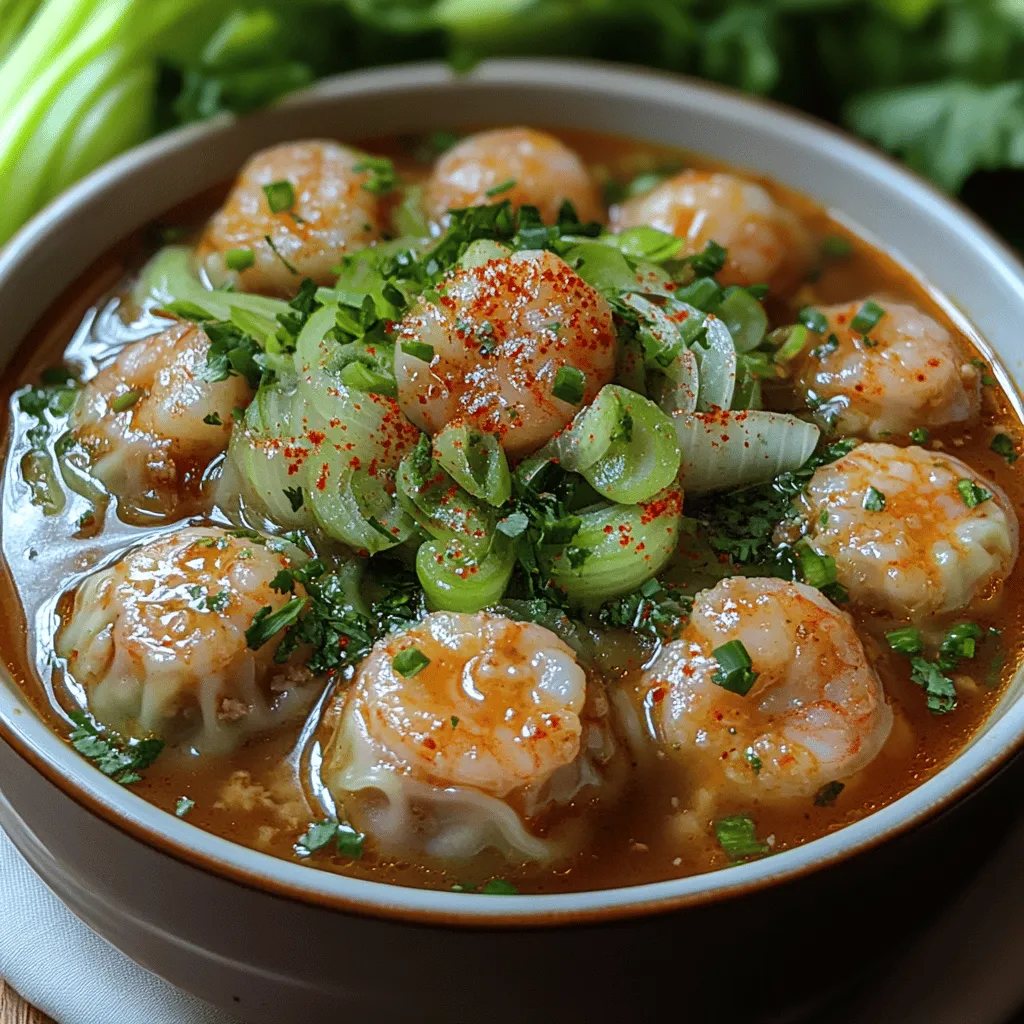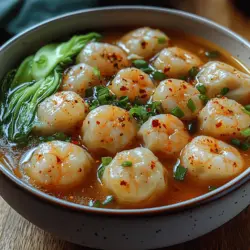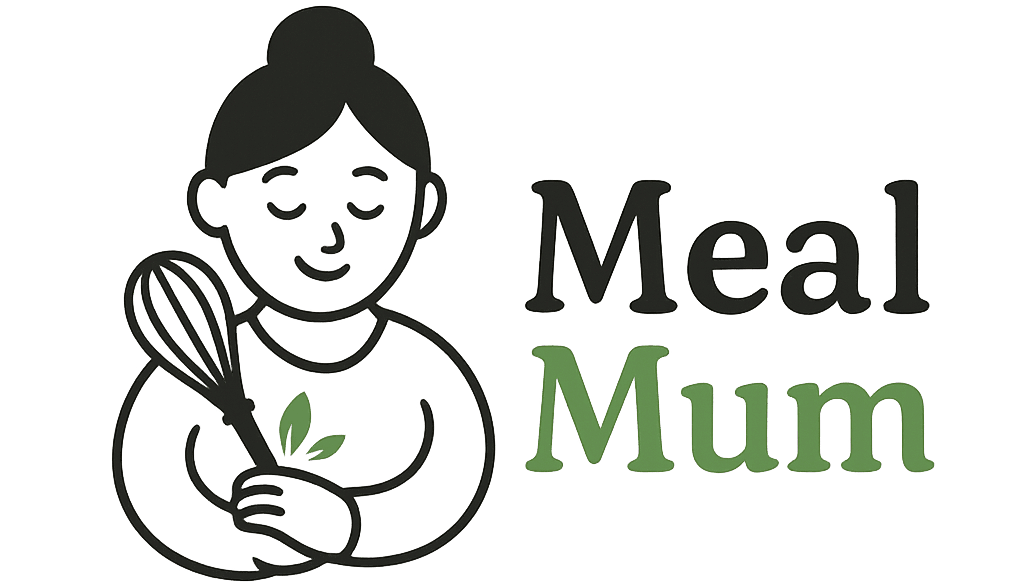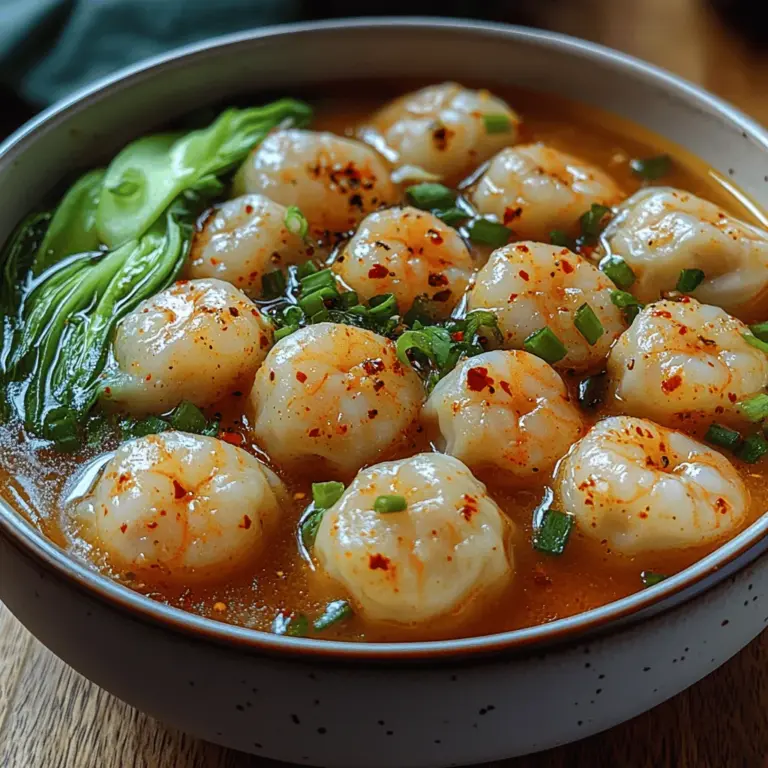Wonton soup is a beloved dish that has warmed hearts and filled bellies for generations. Known for its delicate dumplings and flavorful broth, this comforting soup offers a perfect balance of textures and tastes. In this recipe, we elevate the classic wonton soup by infusing it with a delightful blend of seafood and pork, creating a dish that is not only hearty but also rich in flavor. By making your own wontons and broth, you can achieve an authentic taste that truly stands out.
In this article, we will take you through the captivating world of seafood wonton soup, exploring its historical significance, the ingredients that make it extraordinary, and a comprehensive step-by-step guide to preparing this delightful dish from scratch. Whether you are a seasoned chef or a novice in the kitchen, you will find everything you need to create a bowl of silky seafood wonton soup that will impress your family and friends.
The Allure of Wonton Soup
Wonton soup has deep roots in Asian cuisine, with its origins tracing back to China. The term “wonton” translates to “swallowing a cloud,” a fitting description for the delicate dumplings that float gracefully in a rich broth. Traditionally, wontons are filled with minced meat and served in a clear broth, but as culinary traditions evolved, so did the variations of wonton soup. Each region offers its own twist, from the spicy versions found in Sichuan to the fragrant broths of Cantonese cuisine.
The fusion of flavors in seafood wonton soup brings a unique touch to this classic dish. By incorporating fresh seafood such as shrimp and fish, we enhance the soup’s umami profile, creating a delightful contrast to the savory pork filling. This combination not only elevates the dish but also caters to seafood lovers, making it a versatile option for any occasion.
As we delve into the making of silky seafood wonton soup, we will highlight the importance of using fresh, high-quality ingredients. The magic of this dish lies in the meticulous preparation of the wontons and broth, which can significantly influence the overall flavor and experience.
Understanding the Ingredients
To create a delicious seafood wonton soup, understanding the key ingredients is essential. Each component contributes to the depth of flavor and texture, making it a truly satisfying meal.
Key Ingredients for the Wontons
1. Fresh Shrimp and Ground Pork: The backbone of our wonton filling is a combination of succulent shrimp and tender ground pork. The shrimp add a sweet, briny flavor, while the pork provides a rich, savory base. When selecting shrimp, opt for the freshest available, preferably raw, wild-caught varieties to ensure the best flavor.
2. Aromatics: Aromatics like green onions, ginger, and garlic are essential for elevating the wonton filling. Green onions offer a mild onion flavor, while ginger adds warmth and depth. Garlic brings a robust, fragrant quality that complements the seafood beautifully.
3. Soy Sauce and Sesame Oil: Both soy sauce and sesame oil play crucial roles in enhancing umami flavors. Soy sauce provides a salty, savory element, while sesame oil adds a nutty richness that rounds out the taste profile. Use low-sodium soy sauce to control the saltiness of the dish and allow the other flavors to shine.
Broth Ingredients
The broth is the heart of any good wonton soup, and we have two options to choose from: chicken broth or vegetable broth.
– Chicken Broth: A homemade chicken broth provides a deep, savory foundation for the soup. Its richness complements the flavors of the seafood and meat, creating a harmonious balance. If you’re short on time, store-bought broth can be used, but opt for high-quality, low-sodium varieties for the best results.
– Vegetable Broth: For a lighter option, vegetable broth is an excellent choice. It allows the flavors of the seafood and aromatics to shine through without overpowering them.
In addition to the broth, we will also explore the significance of oyster sauce, which adds a complex, savory flavor that enhances the overall profile of the soup.
Nutritional Benefits of Bok Choy and Garnishes
To finish off the soup, we will incorporate bok choy, a nutrient-rich leafy green that adds both texture and nutrition. Bok choy is low in calories yet high in vitamins A, C, and K, making it a fantastic addition to any meal.
Finally, garnishes such as fresh cilantro and additional green onions provide a burst of freshness and flavor, elevating the dish to new heights.
Step-by-Step Guide to Making Silky Seafood Wonton Soup
Now that we have a solid understanding of the ingredients, let’s dive into the preparation of our silky seafood wonton soup. The first step in this culinary adventure is preparing the filling for our wontons.
Preparing the Filling
1. Gather Your Ingredients: Begin by assembling all your filling ingredients: fresh shrimp, ground pork, green onions, ginger, garlic, soy sauce, sesame oil, and a sprinkle of salt and pepper.
2. Chop and Prepare Aromatics: Finely chop the green onions, ginger, and garlic. The finer the chop, the better they will blend into the filling, ensuring an even distribution of flavor.
3. Prepare the Shrimp: If you’re using whole shrimp, peel and devein them. Roughly chop the shrimp into small pieces, but be careful not to over-process them into a paste. You want small chunks that will provide texture in the filling.
4. Combine Ingredients: In a mixing bowl, combine the ground pork, chopped shrimp, green onions, ginger, garlic, soy sauce, sesame oil, and season with salt and pepper. Use your hands or a spatula to mix the ingredients thoroughly, ensuring everything is well integrated.
5. Taste for Seasoning: Before moving on to filling the wontons, it’s important to taste the filling. You can cook a small spoonful in a pan to check the seasoning. Adjust as necessary, adding more soy sauce, salt, or pepper to your liking.
6. Prepare the Wontons: Lay out a clean surface and have your wonton wrappers ready. Place a small spoonful (about a teaspoon) of filling in the center of each wrapper. Be careful not to overfill, as this can make sealing the wontons difficult.
7. Seal the Wontons: Dip your finger in water and run it along the edges of the wonton wrapper to help seal them. Fold the wrapper over the filling to create a triangle, pressing out any air as you seal the edges. For a traditional look, you can pleat the edges or simply press them tightly to ensure they stay closed during cooking.
8. Repeat: Continue this process until all your filling is used up. You can place the filled wontons on a floured tray to prevent them from sticking together.
With your wontons filled and ready to go, the next steps will involve preparing the broth and cooking the wontons, completing the journey to a steaming bowl of silky seafood wonton soup. Stay tuned as we explore these final stages and bring this delightful dish to life!

Tips for Achieving the Right Texture and Flavor Balance
Creating the perfect Silky Seafood Wonton Soup requires attention to detail, especially regarding texture and flavor. Here are essential tips to help you master your wontons and broth:
1. Seafood Freshness: Always use the freshest seafood available. Fresh shrimp and fish not only taste better but also provide a firmer texture. If you can, buy seafood from a trusted fishmonger or the seafood counter at your local grocery store.
2. Balance of Ingredients: When preparing the filling, ensure a balance between the seafood and aromatics. Too much seafood can lead to a dense filling, while too much seasoning can overpower the natural flavors. Aim for a harmonious mix where each ingredient can shine.
3. Texture of the Filling: For a silky filling, pulse your seafood in a food processor until it reaches a fine but not paste-like consistency. This will provide a smooth texture that complements the delicate wonton wrapper.
Assembling the Wontons
Once your filling is ready, it’s time to assemble the wontons. This step is crucial, as a well-sealed wonton ensures the filling stays intact during cooking.
Visual Descriptions of the Folding Techniques for Wontons
1. Preparing the Wrappers: Lay out your wonton wrappers on a clean, dry surface. Keep a damp cloth over the wrappers you’re not currently using to prevent them from drying out.
2. Placing the Filling: Scoop about a teaspoon of filling onto the center of each wrapper.
3. Folding Techniques:
– Triangle Fold: Fold the wrapper in half diagonally to form a triangle. Press the edges firmly to seal.
– Purse Style: After forming the triangle, bring the two outer corners of the triangle together, pinching them to create a purse shape.
– Classic Fold: Alternatively, you can leave the triangle as is or bring the two opposite corners together, pinching to secure.
Common Mistakes to Avoid When Sealing Wontons
– Overfilling: It’s tempting to add more filling for a heartier wonton, but overfilling can cause breakage during cooking. Stick to a teaspoon or less.
– Insufficient Moisture: Make sure to moisten the edges of the wrappers with a bit of water before sealing. This helps create a better seal.
– Rushing the Sealing Process: Take your time to ensure each wonton is securely sealed. An improperly sealed wonton can lead to leakage during cooking.
Crafting the Broth
A flavorful broth is the backbone of any great wonton soup. Here’s how to craft a rich and aromatic broth that complements your wontons.
Techniques for Sautéing Aromatics to Maximize Flavor
1. Choosing Aromatics: Start with a base of garlic, ginger, and scallions. These three ingredients provide a fragrant foundation for your broth.
2. Sautéing: Heat a tablespoon of oil in a large pot over medium heat. Add minced garlic and ginger, sautéing until fragrant (about 1-2 minutes). Be careful not to burn them, as burnt garlic can impart bitterness.
3. Adding Broth Ingredients: After the aromatics are fragrant, add your broth base—chicken or vegetable stock works well. Bring it to a simmer and let the flavors meld.
Importance of Simmering the Broth for Depth of Flavor
Simmering is crucial for developing a deep, rich flavor. Allow the broth to simmer gently for at least 30 minutes. This slow cooking process allows the flavors from the aromatics and any additional ingredients (like dried mushrooms or seafood shells) to infuse the liquid, resulting in a savory broth that elevates your wonton soup.
Cooking the Wontons
Now that your broth is bubbling away and your wontons are assembled, it’s time to cook them to perfection.
Explanation of How to Know When Wontons Are Perfectly Cooked
Wontons typically take 4-5 minutes to cook when dropped into boiling broth. They are done when they float to the surface and the wrappers appear translucent.
1. Taste Testing: One of the best ways to ensure your wontons are cooked is by tasting one. The filling should be hot and tender, with no raw seafood texture.
2. Visual Cues: The wrappers will become slightly translucent when cooked through, and the filling will have a firm yet tender texture.
Timing the Addition of Bok Choy for Optimal Texture
Bok choy is a wonderful addition to wonton soup, providing crunch and nutrition. To maintain its vibrant green color and crisp texture, add chopped bok choy to the boiling broth just 1-2 minutes before serving. This brief cooking time allows the bok choy to wilt slightly without becoming mushy.
Serving Suggestions
Presentation can elevate your wonton soup from a simple meal to a delightful dining experience.
Presentation Ideas for Serving Wonton Soup
1. Bowls: Use deep, wide bowls to showcase the wontons and broth. The presentation should highlight the delicate wontons floating in the savory broth, garnished with fresh scallions or cilantro.
2. Garnishes: Top each bowl with sliced green onions, cilantro, and a drizzle of sesame oil for added flavor and visual appeal.
Pairing Suggestions for Sides or Beverages
Wonton soup pairs beautifully with various sides and beverages:
– Serve with steamed dumplings or vegetable spring rolls for a complete meal.
– A light, crisp salad with a sesame dressing can complement the richness of the soup.
– For drinks, consider serving a chilled jasmine tea or a light Asian lager to balance the flavors.
Adjusting Spice Levels with Chili Oil and Other Condiments
To cater to varying spice preferences, provide chili oil or fresh sliced jalapeños on the side. This allows guests to customize their bowls according to their heat tolerance.
Nutritional Information
Understanding the nutritional profile of your Silky Seafood Wonton Soup can be beneficial for those monitoring their diet.
Overview of Calories and Nutritional Benefits per Serving
Each serving of wonton soup, which typically includes about 4-6 wontons and a generous amount of broth and vegetables, contains roughly 300-400 calories. This can vary based on the specific ingredients used, but the soup generally provides a balanced combination of protein, carbohydrates, and healthy fats.
Discussion of Possible Dietary Modifications
1. Gluten-Free Options: For those with gluten sensitivities, look for gluten-free wonton wrappers or consider making your own using rice flour.
2. Vegetarian Variation: Substitute seafood with finely chopped mushrooms, tofu, or a vegetable mix for a vegetarian version of this soup.
3. Low-Sodium Broth: If you’re watching your sodium intake, opt for a low-sodium broth or make your own using fresh vegetables and herbs.
The Balance of Protein, Vegetables, and Broth in the Dish
This soup is an excellent source of protein from the seafood, while the bok choy and other vegetables provide essential vitamins and minerals. The broth not only ties all the components together but also keeps the dish light and satisfying.
Conclusion
Silky Seafood Wonton Soup is more than just a meal; it’s a warm, comforting dish that invites you to savor each spoonful. The combination of delicate wontons, aromatic broth, and nutritious vegetables creates a delightful balance of flavors and textures.
As you embark on your culinary journey to make this recipe, remember that cooking is an art form meant to be shared. Whether you’re preparing a cozy dinner for family or hosting friends, the joy of creating and sharing homemade meals fosters connection and love.
I encourage you to try your hand at making this Silky Seafood Wonton Soup. With practice, you’ll master the art of wonton folding and broth crafting, ultimately bringing a taste of comfort and warmth to your table. Embrace the joy of cooking and the satisfaction that comes with sharing your creations with loved ones.


